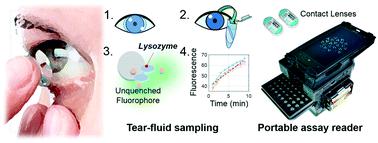Our official English website, www.x-mol.net, welcomes your
feedback! (Note: you will need to create a separate account there.)
Contact lens-based lysozyme detection in tear using a mobile sensor.
Lab on a Chip ( IF 6.1 ) Pub Date : 2020-03-30 , DOI: 10.1039/c9lc01039d Zachary Ballard 1 , Sarah Bazargan , Diane Jung , Shyama Sathianathan , Ashley Clemens , Daniel Shir , Saba Al-Hashimi , Aydogan Ozcan
Lab on a Chip ( IF 6.1 ) Pub Date : 2020-03-30 , DOI: 10.1039/c9lc01039d Zachary Ballard 1 , Sarah Bazargan , Diane Jung , Shyama Sathianathan , Ashley Clemens , Daniel Shir , Saba Al-Hashimi , Aydogan Ozcan
Affiliation

|
We report a method for sensing analytes in tear-fluid using commercial contact lenses (CLs) as sample collectors for subsequent analysis with a cost-effective and field-portable reader. In this study we quantify lysozyme, the most prevalent protein in tear fluid, non-specifically bound to CLs worn by human participants. Our mobile reader uses time-lapse imaging to capture an increasing fluorescent signal in a standard well-plate, the rate-of-change of which is used to indirectly infer lysozyme concentration through the use of a standard curve. We empirically determined the best-suited CL material for our sampling procedure and assay, and subsequently monitored the lysozyme levels of nine healthy human participants over a two-week period. Of these participants who were regular CL wearers (6 out of 9), we observed an increase in lysozyme levels from 6.89 ± 2.02 μg mL-1 to 10.72 ± 3.22 μg mL-1 (mean ± SD) when inducing an instance of digital eye-strain by asking them to play a game on their mobile-phones during the CL wear-duration. We also observed a lower mean lysozyme concentration (2.43 ± 1.66 μg mL-1) in a patient cohort with dry eye disease (DED) as compared to the average monitoring level of healthy (no DED) human participants (6.89 ± 2.02 μg mL-1). Taken together, this study demonstrates tear-fluid analysis with simple and non-invasive sampling steps along with a rapid, easy-to-use, and cost-effective measurement system, ultimately indicating physiological differences in human participants. We believe this method could be used in future tear-fluid studies, even supporting multiplexed detection of a panel of tear biomarkers toward improved diagnostics and prognostics as well as personalized mobile-health applications.
中文翻译:

使用移动传感器基于隐形眼镜检测泪液中的溶菌酶。
我们报告了一种使用商用隐形眼镜(CL)作为样本收集器来感测泪液中分析物的方法,以便使用经济高效的现场便携式阅读器进行后续分析。在这项研究中,我们对溶菌酶进行了定量,溶菌酶是泪液中最常见的蛋白质,与人类参与者佩戴的 CL 没有特异性结合。我们的移动阅读器使用延时成像来捕获标准孔板中不断增加的荧光信号,其变化率用于通过使用标准曲线间接推断溶菌酶浓度。我们根据经验确定了最适合我们的采样程序和测定的 CL 材料,并随后在两周内监测了九名健康人类参与者的溶菌酶水平。在这些经常佩戴 CL 的参与者中(9 人中的 6 人),我们观察到在诱导数码眼实例时,溶菌酶水平从 6.89 ± 2.02 μg mL-1 增加到 10.72 ± 3.22 μg mL-1(平均值 ± 标准偏差) -要求他们在 CL 佩戴期间在手机上玩游戏,以增加压力。我们还观察到,干眼病 (DED) 患者队列中的平均溶菌酶浓度 (2.43 ± 1.66 μg mL-1) 低于健康(无 DED)人类参与者的平均监测水平 (6.89 ± 2.02 μg mL-1)。 1).总而言之,这项研究展示了通过简单、非侵入性采样步骤以及快速、易于使用且具有成本效益的测量系统进行泪液分析,最终表明人类参与者的生理差异。我们相信这种方法可以用于未来的泪液研究,甚至支持一组泪液生物标记物的多重检测,以改进诊断和预后以及个性化移动健康应用。
更新日期:2020-04-24
中文翻译:

使用移动传感器基于隐形眼镜检测泪液中的溶菌酶。
我们报告了一种使用商用隐形眼镜(CL)作为样本收集器来感测泪液中分析物的方法,以便使用经济高效的现场便携式阅读器进行后续分析。在这项研究中,我们对溶菌酶进行了定量,溶菌酶是泪液中最常见的蛋白质,与人类参与者佩戴的 CL 没有特异性结合。我们的移动阅读器使用延时成像来捕获标准孔板中不断增加的荧光信号,其变化率用于通过使用标准曲线间接推断溶菌酶浓度。我们根据经验确定了最适合我们的采样程序和测定的 CL 材料,并随后在两周内监测了九名健康人类参与者的溶菌酶水平。在这些经常佩戴 CL 的参与者中(9 人中的 6 人),我们观察到在诱导数码眼实例时,溶菌酶水平从 6.89 ± 2.02 μg mL-1 增加到 10.72 ± 3.22 μg mL-1(平均值 ± 标准偏差) -要求他们在 CL 佩戴期间在手机上玩游戏,以增加压力。我们还观察到,干眼病 (DED) 患者队列中的平均溶菌酶浓度 (2.43 ± 1.66 μg mL-1) 低于健康(无 DED)人类参与者的平均监测水平 (6.89 ± 2.02 μg mL-1)。 1).总而言之,这项研究展示了通过简单、非侵入性采样步骤以及快速、易于使用且具有成本效益的测量系统进行泪液分析,最终表明人类参与者的生理差异。我们相信这种方法可以用于未来的泪液研究,甚至支持一组泪液生物标记物的多重检测,以改进诊断和预后以及个性化移动健康应用。











































 京公网安备 11010802027423号
京公网安备 11010802027423号